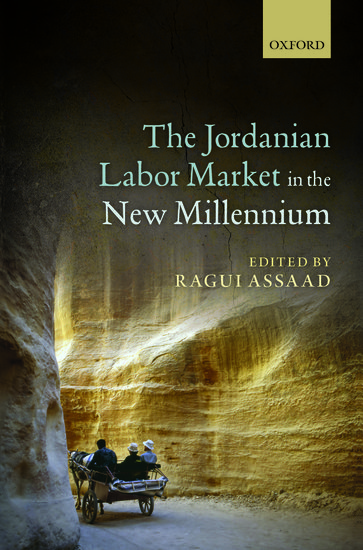This collection aims to cover topics that are essential to understanding the conditions leading to the Arab Spring, including the persistence of high youth unemployment despite healthy economic growth, the co-existence of migration and unemployment, and the unusually early retirement among prime-age workers. For anyone conducting research on Jordan, this book provides careful analyses of the most recent data on the Jordanian labour market and its underlying patterns, writes Henrike M. Hirnstein.
 The Jordanian Labour Market in the New Millennium. Ragui Assaad (ed.). Oxford University Press. 2014.
The Jordanian Labour Market in the New Millennium. Ragui Assaad (ed.). Oxford University Press. 2014.
In the light of recent developments in the Middle East, Jordan has stood out as an oasis of calm and stability. Amid the regional turmoil of the Arab Spring, the Hashemite monarchy faced comparatively little political unrest, and despite its strong dependency on the import of oil, water and food, the Jordanian economy continued with slow but steady growth. But how exactly have Jordanians been integrated in the economy?
For The Jordanian Labor Market in the New Millennium, Ragui Assaad, an expert on economics and politics in the Middle East (Humphrey Institute, University of Minnesota), brings together an interdisciplinary group of scholars. Thematically organised along relevant and often crosscutting factors like gender, age, education, family and migration, the book’s collection of analyses covers a wide range of topics and probes the characteristics and dynamics of employment in Jordan. It draws on newly available data from the Jordanian Labor Market Panel Survey (JLMPS) 2010, a representative household survey undertaken by the Economic Research Forum, the Jordanian Department of Statistics, and the National Centre for Human Resources Development.
Like most parts of the Middle East, young people constitute the majority of the Jordanian society. While drastic political turmoil unsettled Egypt and Syria’s insurrection took a dramatic turn, the Jordanian youth also expressed discontent and democratic aspirations – but popular protests never reached a similar intensity. Given that the socio-economic and political integration of young people has been at the centre of analytical observations about the Arab Spring, what prospects and opportunities has the labour market offered for young Jordanians?
Drawing on JLMPS data from 2010, Mona Amer’s analysis in chapter 3, “The School-to-Work Transition of Jordanian Youth”, traces young people’s paths from school to different forms of employment and reconstructs their transitions and careers within the labour market between 1999 and 2010. Although extensive state investments have allowed young Jordanians to attain much higher levels of education than preceding generations (pp.66-68), the unemployment rate of 15.6 per cent among Jordanians aged 15 to 35 testifies to the difficulties of entering the labour market (p.70). This paradoxical dynamic is especially true for women, who are increasingly well-educated, but face “a deteriorating opportunity structure” (p.105, p.142). Additionally, young Jordanians of a lower educational background experience serious problems attaining socio-economic security and encounter limited opportunities for social mobility. With informal jobs the only entry route into the labour market, it is unlikely that the unemployed will be able to find more secure employment opportunities even ten years later (pp.83-84).

Unfortunately here, the author fails to link the findings to the socio-political landscape in Jordan and the wider region. The mismatch between expectations and opportunities for young people must be interpreted as a potential source of discontent, and can detrimentally affect social cohesion. In this respect, the lack of subjective indicators in JLMPS 2010 data furthermore forfeits the opportunity to advance our understanding of perceptions, ambitions, and frustrations of Jordanians.
With a chapter on migration, the book addresses another important socio-economic factor for living conditions and socio-political stability in Jordan. In chapter 6, “Immigration, Emigration and the Labor Market in Jordan”, Jackline Wahba explores the question how both inward-migration and outward-migration have shaped the Jordanian labour market. On the one side, Jordan has been the destination for large numbers of labour migrants and refugees from neighbouring countries. Wahba’s analysis finds a systematic difference and disadvantage between the employment patterns of foreign and Jordanian workforce. Of all working Non-Jordanians, the vast majority finds informal, temporary, low-skill and poorly paid employment (pp.185-187). In this dynamic, Wahba suggests, immigrants undercut Jordanian wages, but often execute jobs which Jordanians find unattractive (p.187).
Conversely, the Jordanian labour market is marked by a significant flow of outward-migration: Many well-educated Jordanians leave the country for better socio-economic opportunities abroad, mainly in Saudi Arabia and the United Arab Emirates (p.175). This results in a “braindrain” (p.40), but also makes for significant remittances inflows: 4 per cent of Jordanian households receive an average of 2,055 Jordanian Dinar (£2000) annually (p.175). Here, again, the book leaves it up to the reader to interpret how emigration and remittances relate to Jordan’s embeddedness into the global context and how they affect or possibly inhibit dynamics on the Jordanian labour market. This consideration is especially relevant because Jordan, besides remittances, receives strong financial support from geopolitical stakeholders and foreign humanitarian and development donors – a dynamic that decreases the government’s accountability before its people.
Nonetheless, this book comes at a time when such data is scarce though of extreme relevance for understanding labour market dynamics in Jordan. The data allows us to reflect on existing policies and developing adjustments. But the book does not in all respects respond to the need for substantial data about Jordan, a country of great importance for the whole region. For instance, JLMPS 2010 cannot make up for the data gap on migration, as it systematically and heavily underestimates the share of foreign workers (p.182) and outward-migration (p.174).
While I find that this collection of descriptive analyses offers few novel interpretations and conclusions about Jordan’s labour market in its wider socio-political context, one may argue that the publication’s potential lies precisely in its primarily descriptive nature. For anyone conducting research on Jordan, this book provides careful analyses of the most recent data on the Jordanian labour market and its underlying patterns. As the JLMPS 2010 data set is made available online and presents only the first round of what is designed as a longitudinal study, it bears great potential for further research and paves the way for long-term analyses.
Henrike M. Hirnstein is a postgraduate student in the Department of Sociology at the University of Edinburgh. In her research, she analyses the situation of migrants in the Middle East as well as the social dynamics and consequences in receiving countries. In particular, she has explored how the Jordanian society has coped with incorporating large numbers of migrants. Read more reviews by Henrike.







